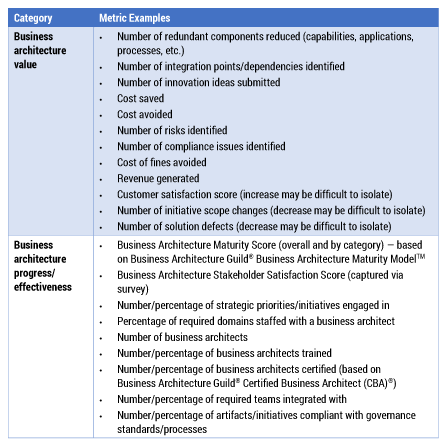One of the most frequent questions business architecture leaders and practitioners ask is about how to measure the success of a business architecture practice. How do we quantify it? How do we prove its value? On the other hand, measuring success is one of the areas where business architecture teams focus the least due to a lack of bandwidth and the obstacles in doing so.
Quantifying the results of business architecture certainly has its challenges, but there are creative ways to do so, even with limited resources. This Advisor describes the benefits and challenges of measuring business architecture success and provides some practical approaches that can be used to accomplish this very important activity.
Benefits of Measuring Business Architecture Success
Many business architecture teams are under pressure to prove the value of the discipline to their organization, even while they are just getting the practice off the ground. This is often due to the fact that business architecture is a relatively new discipline in comparison to those that have been established for decades, so there is initially a lack of understanding and buy-in within most organizations. While there may be more urgency in these cases, it is always a good investment to measure and communicate the value and effectiveness of business architecture within an organization.
First and most importantly, measuring the value provided by business architecture can be used to help increase organizational awareness and adoption of business architecture by the business. This can expand the usage of and advocacy for business architecture. It can also help to secure funding and resources, and not just for the business architecture team, but also for business leaders and their staff to participate in business architecture–related activities and make them a priority.
In addition, measuring the progress and effectiveness of a business architecture practice can be useful information for business architecture leaders and practitioners to demonstrate advancement to their stakeholders. It can also be used as an internal mechanism to identify areas for practice improvement.
Challenges with Measurement
A simple way to look at measurement of business architecture results is to focus on two categories: value provided to the business and progress/effectiveness of the practice. Measuring the progress and effectiveness of a business practice is relatively straightforward, but measuring the value business architecture provides is particularly challenging for a variety of reasons:
-
Some business architecture results are intangible. Benefits such as creating a common understanding, increasing clarity, and informing decisions are difficult to quantify.
-
Business architecture can lead to the avoidance of negative results. Business architecture can lead to better decision making such as deciding not to make a misaligned investment or avoiding a potential compliance issue before it happens.
-
Business architecture results can be hard to isolate. Business architecture increases the success of other disciplines and can lead to results such as making better portfolio management decisions and reducing project scope changes. However, other teams, disciplines, and techniques also contribute positively to these outcomes as well.
-
Business architecture results can create unwanted visibility. What might be a win for business architecture, such as identifying business or IT redundancy or integration issues, may not be perceived as such by the leader responsible for them, even if they do need to be addressed. Communication on issues such as these requires careful organizational navigation and, in some cases, the business architecture team may need to stay in the background while others take the credit.
Choosing the Right Business Architecture Metrics
As with any data collection and reporting effort, the audience for the information and an understanding of how they will use it should be defined up front. The executive responsible for business architecture is typically a key consumer along with other business leaders in the business and IT, and, of course, the business architecture team.
Along with the audience and purpose, a key input to selecting the right business architecture metrics is the defined value proposition of the business architecture team. For example, a business architecture team focused on transformation will measure results such as customer satisfaction where a team focused on efficiency will measure results such as cost savings. In addition, the metrics selected — as well as the business architecture team’s value proposition — should align with the organization’s strategic priorities to ensure that they are relevant and well received.
Practical Approaches to Measure Business Architecture Success
Due to some of the challenges mentioned previously, taking a practical approach to business architecture measurement will increase success of the activity. A few key tips:
-
Capture both measurable and nonmeasurable results. There is typically a strong desire for quantifiable metrics, but qualitative ones can provide just as much value and help tell the story. It is ideal to capture both. Capture short success stories as well as quotes and anecdotes that describe how business architecture was used in various scenarios and the value it provided. These methods are particularly helpful for capturing the intangible value of business architecture, such as the benefits of having a common language.
-
Keep the metrics and reporting simple to start. Resist the urge to create a long list of complex metrics to report on. A simple approach is best to start, especially for a new business architecture practice. Select just a few simple metrics to start, and start measuring them. Additional metrics and more complex ones can be added later. In the beginning, measuring business architecture results is most easily done with simple measures like counts. The information may even need to be collected manually in the beginning. It is better to start capturing and reporting on a baseline of information versus delaying the activity to pursue more complex approaches.
-
Start measuring your results from the beginning. If you follow a practical approach and limit the information you capture and report on, you can begin capturing business architecture results as soon as you establish your practice. Having information captured from the very beginning will prove to be valuable for history and buy-in purposes, even if it is just for two or three metrics along with a set of documented success stories.
Getting Started with Business Architecture Metrics
While the options for measuring business architecture value and progress/effectiveness are endless, Table 1 shows just a few examples of some simple metrics you can capture to get you started.

While quantifying the results of business architecture may be challenging, a consistent, simple, and practical approach to measuring its quantitative and qualitative impact can make this activity a realistic one, even with limited resources. Capturing this information from the very beginning when a practice is established will provide the proof necessary to demonstrate the case for business architecture, increase advocacy for the discipline across the organization, and provide a basis for celebrating success.



